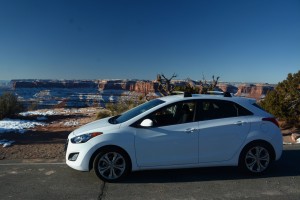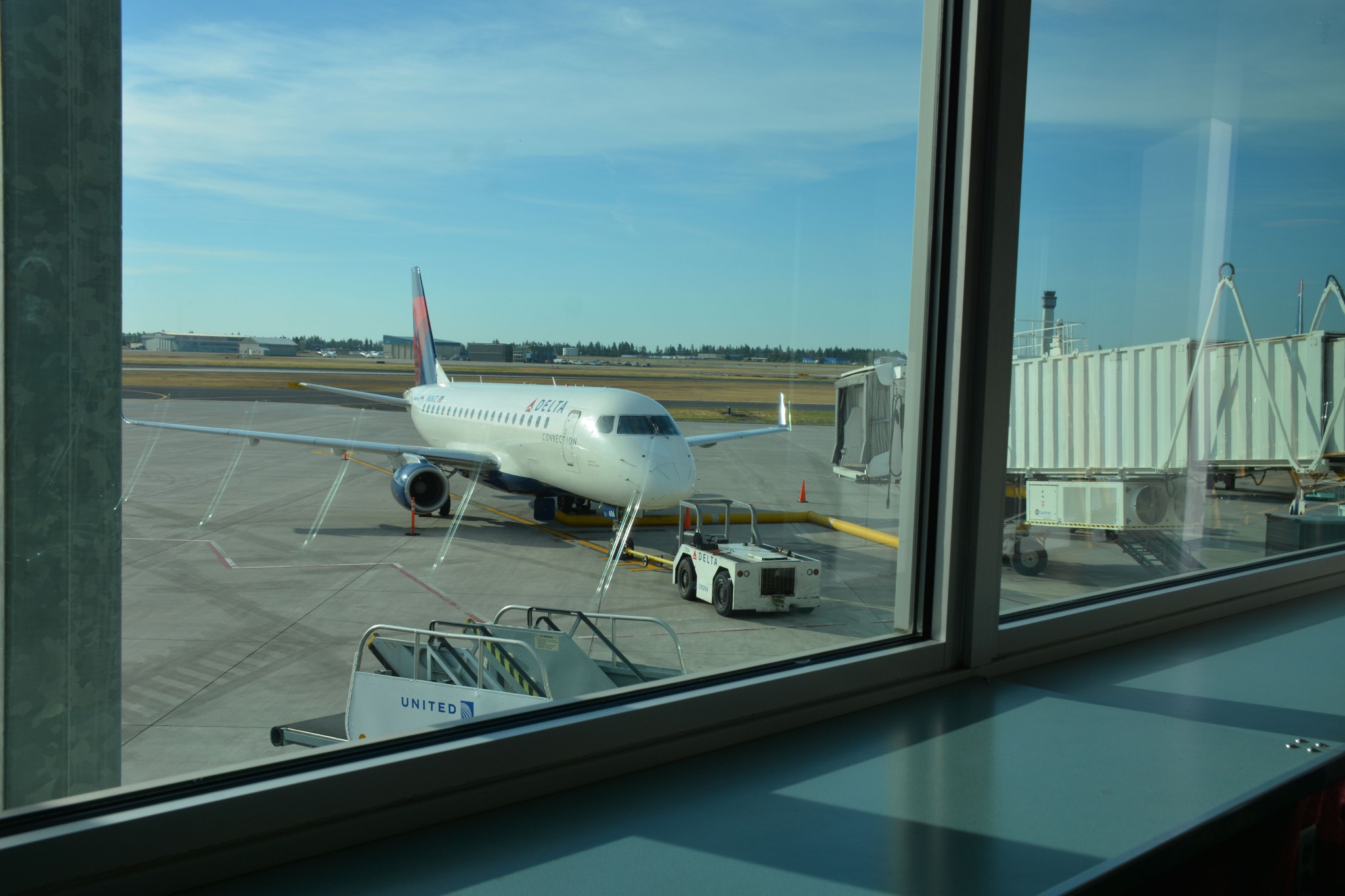In this post we will consider the structure of a road trip. That includes your transportation options, accommodations and other major elements of life on the road. Pictured above is one option – flying part of the way, then road-tripping in a rental car. This Delta EM175 is waiting at Spokane Airport to take me and 75 other people to Los Angeles in June.
Transportation options – an example
Let’s say you live in Long Beach, California, and you (plus your significant other) want to visit Yellowstone National Park. You’ve decided you want to visit Old Faithful, Yellowstone Falls and see some wildlife. You also want to spend a day in Grand Teton National Park. If possible, you’d also like to visit the great Montana ghost town of Bannack and the old mining town of Virginia City.
I could recommend an itinerary that would let you do all this is nine days, driving the entire distance. But I could also recommend an itinerary that would let you do the same things in just five days. The difference? You fly part of the way, then rent a car.
What about the cost, you ask? First, we’ll figure 30 miles and $3 per gallon, $400 for the car rental, $100 per night for a hotel, and $40 per person for food. You can fly Jet Blue or Delta nonstop from Long Beach to Salt Lake City for $210. Flight time is 1:40. Figure $15 per day for airport parking.
You’ll pass through Salt Lake if you drive, too. So our time savings is the round-trip from Long Beach to SLC. By my calculations, the transportation cost of flying is just about $300 more than driving the entire route. It’s the rental car cost that more than makes the difference. We’re allowing two days each way to drive to SLC.
But here’s the decision: What is four days of your time worth? That will probably include three days each of precious vacation time for two people. And what you’ll miss is a 700-mile, 15-hour, mind-numbing slog up I-15 through Las Vegas to Salt Lake. If you’d like to see my itinerary comparison, scroll down to the end of this post.
For me, it’s now about 50-50 between fly-drive and all flying. I’m more likely to drive the whole trip now that I’m retired. Here are the advantages:
- I’m used to the car and its controls
- I’m guaranteed to have satellite radio and an iPod connection
- I can take more stuff – mostly backup photo equipment. No more trying to wedge a tripod into a rollerboard bag.

Of course, fly-drive is the only viable option for visiting destinations that are a considerable distance. In July I flew to Kansas City; in September I’m flying to Atlanta.
The same process can apply no matter where you live. If you’re in Chicago, say, and you want to visit the Colorado Rockies, you can fly to Denver on American or United for $251. Flight time is 2:40. The alternative is to drive all the way across Illinois, Iowa, Nebraska and eastern Colorado – hardly scenic highlights – and two full days of cornfields each way.
Airfares
Getting low airfares is a crapshoot and can be very time-consuming. I’ll devote an entire article to airfare strategies in a future post. The good news is that airfares are relatively reasonable, if you know how to search. For now, I suggest you use Expedia or Travelocity to research airfares — you don’t have to buy anything.
Car rentals
Renting a car typically costs as much as a plane ticket – sometimes more. I don’t have a strategy for getting low rental rates. They’re becoming exorbitant, especially for airport rentals, where you get taxed to death. In most locations, I pay between $400 and $500 for a week in an intermediate car (like a Hyundai Sonata or Santa Fe).
I like being able to go from the baggage claim right to my car without waiting in line, so I have Avis Preferred and National Emerald Club. The nice thing about National is a chance to pick from whatever is on the so-called “Emerald Aisle.” I try to get a Hyundai, because I’m familiar with their products, and I have a i-Pod cable that works in any Hyundai. I also want satellite radio. Car rental companies let the trial subscription lapse, meaning only their newer vehicles have the service. I usually ask one of the lot porters if he/she’s noticed an active XM or Sirius subscription on any of the vehicles there.
Where to stay
Not only do I stay in hotels, I make prepaid reservations. I know, this takes some of the adventure and spontaneity out of road-tripping. Forgive me; I’m old. I like the predictability. If you insist on going in summer, it’s pretty much a necessity, even for many campsites. There are lots of web booking sites out there. I use Expedia and am mostly satisfied with it. I read the Expedia and Trip Advisor reviews to make sure I stay in nice places. And I check the room photos in Expedia hoping to see a work desk with its own lamp. One of my pet peeves about hotels/motels is lack of a work space, along with lack of an electrical outlet for a laptop. I also look for an elevator, because I’m too old to shlep three pieces of luggage up a flight of stairs.
Another thing I look for is a free continental breakfast. High-end hotels typically don’t offer this, but motels like Super 8, Days Inn, and Best Western usually do. What about wi-fi? I find it interesting that a big Marriott hotel will charge you $15 a day for wi-fi, but it’s free at the Super 8.
Food
I rarely eat at Subway when I’m home, but on road trips it’s my standard lunch spot. The food is reasonably healthy, and you can eat it while you drive, or carry it until you find a nice picnic spot. Subways are ubiquitous; every town has at least one. For dinner, I use Yelp. Often I’ll do a search before I leave on the trip, so I know what the dinner options are.
Other topics
What about camping? I confess I’m ignorant there. I don’t camp. And how about motorcycle rentals? Is it feasible to fly somewhere, then rent a bike for road-tripping? It must be, but I don’t know. I do know you can rent an RV. The company whose vehicles I see most often is Cruise America. I’m sure there are many others.
Comments?
Please submit a comment if you’re able to add to this discussion.
APPENDIX: Fly/Drive Itinerary
Option 1: Fly plus drive
Day 0 – Evening flight to Salt Lake City
Day 1 – Salt Lake City to Dillon, Montana. Visit Bannack ghost town in afternoon. We’ll have a Road Less Traveled article on Bannack in a future update of this blog.
Day 2 – Drive through Virginia City to West Yellowstone and enter Yellowstone National Park. At first junction, turn right and visit Old Faithful and nearby geyser basins. Then drive to Gardiner, Montana, at park’s north entrance.
Day 3 – Drive east from Mammoth Springs to Lamar Valley. This is the best route for wildlife. If Hayden Pass is open, drive south to the Grand Canyon of the Yellowstone, then cross park to West Yellowstone. If not, you’ll have to retrace your steps. Overnight in West Yellowstone
Day 4 – Revisit and spend more time in Old Faithful area, then drive to south entrance and on to Grand Teton National Park. Turn right at Moran Jct. onto park road, and follow it through the park. Overnight in Jackson.
Day 5 – Do a park loop, starting on the main highway (US 26/89/191) to Moran, then drive the park road in morning light. Just before Moran Jct., stop at Oxbow Bend – good spot for wildlife. Lunch in Jackson, then 4-5 hour drive to Salt Lake City airport for flight home.
OPTION 2: All driving
Days 1 and 2 are driving from home to Salt Lake City
Days 3-7 are the same as Days 1-5 above
Days 8 and 9 are driving home from Salt Lake City

